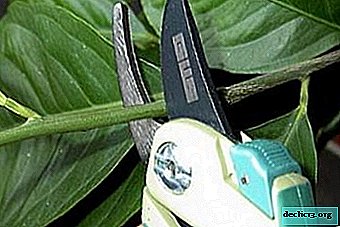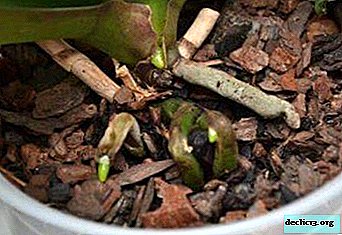Why is lemon crown formation needed? How to carry out the procedure at home?

A lemon tree is not uncommon on the windowsills of apartments. This unique and very useful plant has been increasingly grown in apartment conditions. It not only pleases the eye, but also benefits in the form of lemons.
And in order to get them guaranteed, the plant should be regularly cut to form a crown.
This article describes in detail how to properly form a lemon crown at home.
Why is it necessary to form?
A lemon tree is grown to produce lemons, and a well-formed crown contributes to good fruiting. If you do not do this, a long trunk with leaves at the top will stretch, not able to bear fruit.A properly developing tree should have this structure:

- during the first year, a vertical shoot is formed - a stalk of the first order;
- then side branches appear on it, which also belong to the first order, they should leave 3-4 pieces;
- on them, in turn, will appear sprouts of the second order, etc .;
- as shoots of the fourth order appear, the tree begins to form fruits.
A lemon with a correctly formed crown, which consists of skeletal branches and small branches, looks more beautiful and bears fruit better.
Is it obligatory to do this?
The formation and then maintaining the shape of the crown is mandatoryas when growing any fruit tree. In this case, pruning is recommended not often, but only if necessary, so as not to weaken the plant.
It is mandatory when necessary:
- to form a crown or maintain its shape (forming pruning);
- remove dry or diseased branches (sanitary);
- stimulate fruiting in "old" plants, which are 17-20 years old (rejuvenating).
What time is better, is it possible with fruiting?
Opinions about the best timing of the procedure differ. Every season has adherents, i.e. work is allowed throughout the year, but - except for the period of fruiting. Pruning should be done after collecting lemons.. Nevertheless, spring, March-April is considered the most suitable time.
When choosing, one should take into account the purpose of the procedure. So:
- forming lemon pruning is recommended in the spring (March, April);
- anti-aging is also done in March-April;
- fatliquoring shoots should be removed in the initial stage, i.e. in any season;
- sanitary pruning is also carried out year-round.
From a fattening shoot it is possible to make a fruiting one if you give it a horizontal direction, carefully tilting it, and pinch it when it reaches a length of 10-15 cm.
How to form?
Consider how lemon, growing in a pot, correctly form a crown at home. The crown is formed within 2-3 years, one trimming to get the desired result is not enough.
Step-by-step instruction

- The first pruning of a young plant.
What to do: crown formation should start from the trunk, cutting it at a height of 20-60 cm. Four kidneys should be left on the trunk, pointing in different directions - these are future skeletal branches.
- Cut of shoots of the second and subsequent orders.
What to do:
- the length of the shoots of the second order should be 20-25 cm, i.e. 5 cm shorter than first order branches;
- the length of the branches of the next order should also be less than the previous 5 cm;
- to get a horizontal branch, the kidney closest to the pinch / cut point should be facing the outside of the crown or down;
- for vertical - such a kidney should be directed to the center of the crown or up.
- The formation of skeletal branches.
What to do:
- twigs that grew on the trunk from the kidneys left during pruning and reached 20-30 cm should be nipped to stop their further growth;
- sprouts appearing at the base of the trunk are plucked, because at a height of 30-40 cm there should be no side shoots.
- Removing branches after harvesting and pinching extra shoots.
What to do:
- twigs growing inside the crown, as well as intersecting, pinch, shortening by a third or half;
- after harvesting, each fruiting shoot is cut to a young lateral sprout.
The formation of the crown is completed by trimming the branches of the fourth or fifth orders.
When the branch is completely removed, it must be cut off at the base. If you only need to shorten the shoot, then a sharp knife makes a cut above the kidney by 3-4 mm.The shape of the crown can be different: bush, cube or pyramid. But the most optimal option is a flat shape - like a living curtain.
Flat crown shape has these advantages.:
- It is easy to place the plant on the windowsill so that it is evenly lit, and this is an important factor for lemon.
- The tree is more active in fruiting. To get a flat crown, you need to bend and direct the shoots growing in the direction of the room along the windowsill at the very beginning. When the branches reach the borders of the window connector, trim or pinch them.
What happens if you cut too much?
 Trimming can be short and long, resulting in different results.:
Trimming can be short and long, resulting in different results.:
- short - contributes to the emergence of new shoots;
- long - Stimulates the formation of fruit buds.
If you cut too much, you need to wait for new shoots and the next pruning, remember that each shoot should have several buds.
Further care
When forming the crown of the branch in the places of the cut, it is necessary to treat with any antisepticto avoid plant disease. As an antiseptic, a garden var is used or the places of cuts are dusted with wood ash. Thin branches can not be processed.
To get an annual harvest, the lemon tree will have to pay regular attention. But with proper and timely pruning and maintaining the shape of the crown, a lemon tree can bear fruit for more than one year.

















